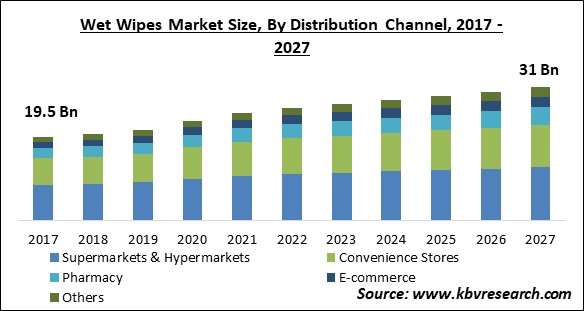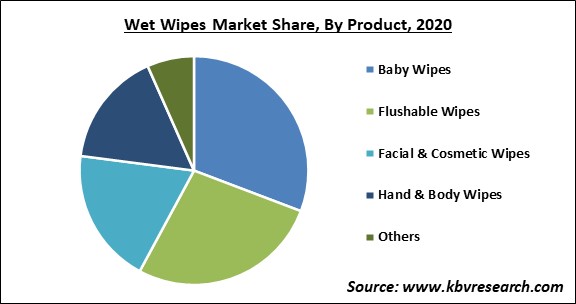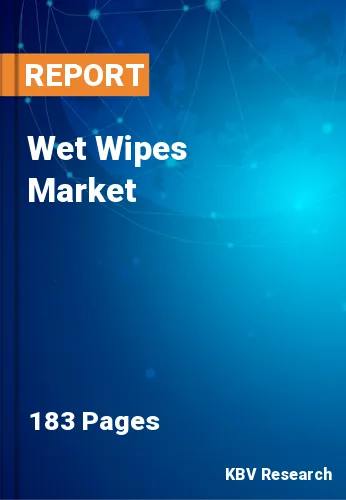The Global Wet Wipes Market size is expected to reach $31 billion by 2027, rising at a market growth of 3.6% CAGR during the forecast period.
A wet wipe is a moistened piece of plastic or fabric that is folded and individually wrapped for convenience, or as a long roll with individual wipes that can be peeled off in the case of dispensers. Wet wipes can be used for multiple cleaning purposes such as cleaning hands, wiping oil off the face, and for intimate hygiene. In addition, wet wipes can also be used with the purpose to clean objects or surfaces, etc.
One of the key factors that is responsible for the increased utilization of wet wipes across the world is the rise in the global newborn population. The rising population of infants is constantly increasing the demand for wet wipes. The skin of newborn babies is very sensitive and supposed to be handled with care. Due to this, parents are highly adopting wet wipes to maintain the hygiene of their children.
Moreover, more women are entering the workforce around the world which has increased their purchasing power and raised their awareness of personal hygiene, and these aspects are supporting the growth of products that are made to offer cleanliness and sanitation to people. As a result of the diverse usage of hygiene and cleanliness products, other goods such as intimate wipes, flushable wipes, feminine wipes, and scented wipes have been rolled out in the market, which help in cleaning and eliminating bacteria on the skin as well as minimizing the risk of infection and skin irritation.

The outbreak of the hazardous COVID-19 pandemic led the world’s economic infrastructure to a steep downfall. A lot of businesses irrespective of their sizes were devastated while the healthcare infrastructure of almost every country was overburdened. During the pandemic, the major focus of everyone was on sanitation and hygiene. As the number of cases of Covid-19 increased rapidly around the world, the serious risk of the virus transmission has prompted panic buying among consumers of personal hygiene products.
In this time of economic distress, consumers have become more mindful of their spending and have opted for low-cost alternatives such as economical baby wipes rather than high-priced specialty wipes. Furthermore, these wipes are offered in bulk packaging containing many wipes, making them one of the most popular wipes among consumers. Therefore, the product is in high demand due to the above-mentioned factors.
Wet wipes can be used in a broad variety of settings according to the requirement of the customer. Wet wipes can be used in the medical/healthcare sector with the purpose to clean wounds of the patient, in offices to clean dirt, bacteria, and germs off the surfaces, and in factories and warehouses to wipe dirt and pollution off the face along with a moisturized finishing.
In the last few years, the awareness about killing viruses and bacteria has been increased due to the outbreaks of various pandemics such as COVID-19, SARS, Swine flu, viral pandemics, Western African Ebola virus, Zika virus, and others. Moreover, due to the high penetration of social media, people have become conscious of maintaining an optimum level of cleanliness around them. As a result, these have begun to adopt wet wipes and tissues to clean their body and other surfaces.
Wet wipes are usually made up of microplastic fiber which is not biodegradable which means that it will stay in the environment for a very long duration. Moreover, these products are made with use and throw purpose, which can cause environmental concerns. Moreover, a lot of people flush the wet wipes after using them. These used wipes can neither be reused nor be biodegraded. Also, the used wet wipes can further end up in oceans and then generate problems in wastewater systems.

Based on the product, The Wet wipes market is segregated into Baby Wipes, Facial & Cosmetic Wipes, Hand & Body Wipes, Flushable Wipes, and Others. In 2020, the baby wipes segment acquired the largest revenue share of the wet wipes market. One of the major factors driving the growth of this segment is constantly increasing spending capacity of the consumer on baby care products across the world. Due to the rising concerns of parents toward sensitive skin of their babies, particularly in the diaper area, the majority of consumers prefer to use baby wipes that offer a safe and smooth finishing during the cleaning process and avoid the chances of rashes.
Based on the distribution channel, the Wet wipes market is categorized into Supermarkets & Hypermarkets, Convenience Stores, Pharmacy, E-commerce, and Others. In 2020, the convenience store segment acquired the substantial revenue share of the wet wipes market. The significant revenue of the market is attributed to the huge number of convenience stores in almost every locality which increases the accessibility of daily use items for people. Moreover, convenience stores get consistent supply of the day-to-day essential products which plays a major role in fulfilling the demand of the wet wipes across customers.
| Report Attribute | Details |
|---|---|
| Market size value in 2020 | USD 23.2 Billion |
| Market size forecast in 2027 | USD 31 Billion |
| Base Year | 2020 |
| Historical Period | 2017 to 2019 |
| Forecast Period | 2021 to 2027 |
| Revenue Growth Rate | CAGR of 3.6% from 2021 to 2027 |
| Number of Pages | 183 |
| Number of Tables | 299 |
| Report coverage | Market Trends, Revenue Estimation and Forecast, Segmentation Analysis, Regional and Country Breakdown, Companies Strategic Developments, Company Profiling |
| Segments covered | Product, Distribution Channel, Region |
| Country scope | US, Canada, Mexico, Germany, UK, France, Russia, Spain, Italy, China, Japan, India, South Korea, Singapore, Malaysia, Brazil, Argentina, UAE, Saudi Arabia, South Africa, Nigeria |
| Growth Drivers |
|
| Restraints |
|
Based on the Regions, the Wet wipes market is analyzed across North America, Europe, APAC, and LAMEA. In 2020, North America emerged as the leading region in the overall wet wipes market by holding the largest revenue share. Some of the growth catalysts for the regional market are evolution in the lifestyle of people, a significant growth in the number of working women, rising internet retailing tendencies, and constantly increasing disposable income of people. Furthermore, increased awareness about the necessity of baby hygiene among parents, increasing importance toward intimate hygiene, and advantages of sanitation are driving demand for wet wipes in the regional market.
Free Valuable Insights: Global Wet Wipes Market size to reach USD 31 Billion by 2027
The market research report covers the analysis of key stake holders of the market. Key companies profiled in the report include Nice-Pak Products, Inc., Kimberly-Clark Corporation, WipesPlus, PDI Healthcare, Inc., Essity Aktiebolag (publ), Reckitt Benckiser Group PLC, The Clorox Company, The Procter and Gamble Company, and The Honest Company, Inc.
By Product
By Distribution Channel
By Geography
The Wet Wipes market size is projected to reach USD 31 billion by 2027.
Growing applications in various sectors are driving the market in coming years, however, non-biodegradable nature limited the growth of the market.
Nice-Pak Products, Inc., Kimberly-Clark Corporation, WipesPlus, PDI Healthcare, Inc., Essity Aktiebolag (publ), Reckitt Benckiser Group PLC, The Clorox Company, The Procter and Gamble Company, and The Honest Company, Inc.
As the number of cases of Covid-19 increased rapidly around the world, the serious risk of the virus transmission has prompted panic buying among consumers of personal hygiene products.
The Supermarkets & Hypermarkets market is leading the segment of the Global Wet Wipes Market by Distribution Channel 2020, and would continue to be a dominant market till 2027.
The North America market is generating highest revenue in the Global Wet Wipes Market by Region 2020, and would continue to be a dominant market till 2027.
Our team of dedicated experts can provide you with attractive expansion opportunities for your business.

